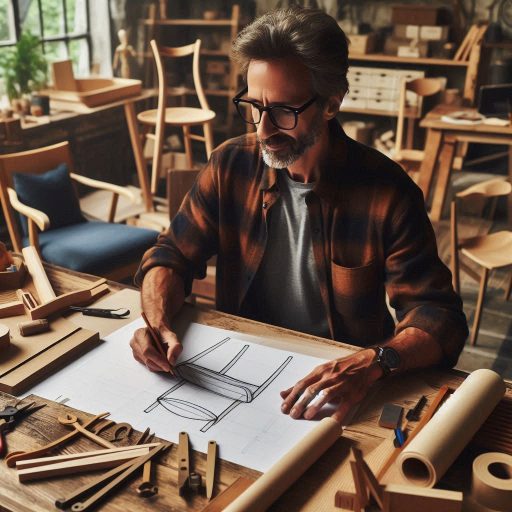Introduction
Starting your own furniture design business can be an exciting journey.
This venture allows you to express your creativity while crafting functional pieces.
The furniture industry is evolving, and many consumers seek unique and custom-made options.
As mass-produced furniture saturates the market, the demand for personalized designs continues to grow.
Consumers increasingly desire items that reflect their individual tastes.
They want furniture that tells a story or enhances their living spaces.
This shift presents a golden opportunity for aspiring designers.
You can fill the gap by offering custom solutions that meet specific needs.
Unique furniture not only stands out but also resonates with buyers on a personal level.
Passion plays a vital role in this industry.
Designers often channel their love for aesthetics into their creations.
Your enthusiasm can lead to innovative designs that capture attention.
Every piece you create can showcase your artistic vision and craftsmanship.
This passion fuels your drive to succeed and pushes you to explore new ideas.
In addition to creativity, starting a furniture design business demands practical skills.
Understanding materials, construction techniques, and design principles is essential.
You‘ll need to stay updated on trends and customer preferences.
Researching the market helps you identify gaps and opportunities.
This knowledge equips you to make informed decisions as you launch your business.
Research and Planning
Starting a furniture design business begins with thorough research and planning.
Conduct Market Research to Identify Target Audience and Competitors
First, conduct market research to identify your target audience.
Understanding who will buy your furniture is essential.
Look for trends in consumer preferences and buying habits.
Analyze demographics, such as age, income, and lifestyle.
This information will help shape your designs and marketing.
Next, study your competitors.
Identify local and online furniture designers.
Analyze their strengths and weaknesses.
Note their design styles, pricing, and customer feedback.
Understanding the competitive landscape will guide your unique approach.
Differentiate your business by offering something new or better.
Create a Business Plan Outlining Goals, Budget, and Marketing Strategies
After gathering this information, create a comprehensive business plan.
Outline your goals, budget, and marketing strategies.
Clearly define your mission and vision for the business.
Set short-term and long-term goals to measure success.
Consider your startup costs, including materials, tools, and marketing expenses.
Budgeting is crucial.
Estimate your initial investment and ongoing expenses.
Factor in costs for supplies, labor, and overhead.
Determine how much revenue you need to break even.
Establish pricing strategies that reflect your value while remaining competitive.
Next, focus on marketing strategies.
Identify channels to reach your target audience.
Consider social media platforms, online marketplaces, and local events.
Create a content plan to promote your designs and engage with potential customers.
Use eye-catching visuals to showcase your furniture on social media.
Building an online presence can attract customers and generate interest.
Determine the Niche and Style of Furniture Designs You Want to Specialize In
Now, determine your niche and style of furniture designs.
Think about what excites you and what you excel at.
Are you drawn to modern, minimalist designs or rustic, handcrafted pieces? Defining your niche will help you attract the right customers.
It also sets you apart from competitors.
Additionally, consider the materials and processes you want to use.
Eco-friendly materials can appeal to environmentally conscious consumers.
Research different manufacturing techniques that suit your design style.
Whether you prefer woodworking, upholstery, or metalworking, ensure you have the necessary skills or partnerships.
Finally, plan how to evolve your designs over time.
Stay updated with design trends and customer preferences.
Attend trade shows, workshops, and design exhibitions.
Continuous learning and adaptation will keep your business relevant and innovative.
In a nutshell, research and planning lay the foundation for your furniture design business.
By understanding your market, creating a solid business plan, and defining your niche, you position yourself for success.
Take the time to prepare, and your passion for design will flourish.
Read: Top Skills Needed for Art Educators and Instructors
Legal Requirements
Starting a furniture design business involves navigating various legal requirements.
Register Your Business and Obtain Necessary Permits and Licenses
Registering your business is a crucial first step.
This establishes your brand and allows you to operate legally.
Choose a unique name that reflects your vision.
Once you have a name, register it with your local government.
This process often includes filing a “Doing Business As” (DBA) form.
Next, obtain necessary permits and licenses.
Research local and state regulations that apply to your business.
Some areas require specific permits for manufacturing furniture.
Others may need zoning permits if you operate from home.
Don‘t overlook the importance of business licenses.
They demonstrate your compliance with local laws and regulations.
Set Up a Legal Structure, Such as a Sole Proprietorship or LLC
Setting up a legal structure is also vital.
You can choose from several options, including a sole proprietorship, partnership, or Limited Liability Company (LLC).
A sole proprietorship is simple and requires minimal paperwork.
However, it does not provide personal liability protection.
An LLC offers more protection by separating your personal assets from your business liabilities.
Consider the benefits of an LLC carefully.
It shields your personal finances if your business faces legal issues.
Additionally, it can enhance your credibility with customers and suppliers.
Consult a legal professional to help you decide the best structure for your needs.
They can guide you through the formation process and ensure you meet all legal requirements.
Ensure Compliance with Safety and Environmental Regulations in Furniture Production
Compliance with safety and environmental regulations is crucial in furniture production.
Research the specific regulations that apply to your designs and materials.
Safety standards often dictate how you manufacture your products.
This includes materials used, construction methods, and product labeling.
Environmental regulations focus on sustainability and waste management.
Ensure that your materials are sourced responsibly.
Choose sustainable options whenever possible, as this can attract eco-conscious customers.
Implement waste reduction strategies in your production process.
This not only helps the environment but also improves your bottom line.
You may need to conduct regular inspections and audits to ensure compliance.
Establishing a safety protocol for your workshop is essential.
This includes training employees on safe practices and using personal protective equipment.
Documenting your compliance efforts can protect your business in case of disputes.
In summary, understanding the legal requirements is vital for your furniture design business.
Register your business, obtain permits, and set up the appropriate legal structure.
Always prioritize safety and environmental compliance to build a reputable brand.
By doing so, you position your business for long-term success in a competitive market.
Read: Essential Skills for Aspiring Costume Designers
Setting Up Your Workspace
Starting your own furniture design business requires a well-planned workspace.
The right environment can enhance your productivity and creativity.
Here are three essential steps to setting up your workspace effectively.
Choose a Suitable Location
Selecting a suitable location for your workshop or studio is crucial.
Consider factors like accessibility, space, and ambiance.
A location near suppliers can save time and transportation costs.
If you work with larger pieces, ensure your space has adequate room for materials and tools.
Proper ventilation is also essential, especially when working with finishes or adhesives.
A dedicated space allows you to focus on your craft without distractions.
Whether you choose a garage, basement, or rented studio, ensure it meets your business needs.
Invest in High-Quality Tools and Equipment
Quality tools and equipment make a significant difference in furniture design and production.
Invest in essential woodworking tools such as saws, routers, and drills.
High-quality tools enhance precision and reduce frustration during the design process.
Don‘t forget about safety gear, like goggles and ear protection.
Ergonomic furniture is also important for your workspace.
A comfortable chair and adjustable desk can improve your posture and productivity.
Consider adding storage solutions to keep your tools organized.
A well-equipped workspace fosters efficiency and encourages creativity.
Create a Comfortable and Inspiring Workspace
Your workspace should be comfortable and inspiring to boost your creativity.
Start by choosing a color scheme that motivates you.
Soft, neutral tones can create a calming atmosphere.
Add personal touches like artwork or photos that inspire you.
Good lighting is vital; consider natural light for daytime and adjustable artificial lighting for nighttime work.
Organize your materials and tools in a way that is visually appealing and functional.
A clutter-free environment reduces stress and allows you to focus on your projects.
Incorporate plants or natural elements to enhance your workspace’s ambiance.
Essentially, setting up your workspace is a vital step in launching your furniture design business.
Choose a location that fits your needs and inspires creativity.
Invest in high-quality tools and equipment to elevate your work.
Finally, create an inviting workspace that encourages innovation.
By carefully considering these elements, you can cultivate a productive environment that supports your design vision and fuels your passion for furniture design.
Read: Building a Portfolio for Costume Design

Sourcing Materials
Sourcing quality materials is crucial for any furniture design business.
Start by researching reliable suppliers who offer the best options.
Look for suppliers that specialize in wood, metal, fabrics, and other essential materials.
Attend trade shows and industry events to discover potential partners.
Networking at these events can lead to valuable connections.
Research and Establish Relationships with Reliable Suppliers of Wood, Metal, Fabrics, and Other Materials
Once you identify suppliers, establish relationships with them.
Good communication helps build trust and ensures consistent quality.
Reach out to multiple suppliers for quotes and availability.
This way, you can compare prices and services effectively.
Consider creating a shortlist of preferred suppliers for future reference.
Consider Sustainability and Eco-Friendly Options for Your Furniture Designs
Sustainability should be a priority in your sourcing decisions.
Eco-friendly materials attract environmentally conscious customers.
Research sustainable options like reclaimed wood, recycled metals, and organic fabrics.
Many suppliers now offer green alternatives that align with your values.
Using sustainable materials not only benefits the planet but also enhances your brand image.
Negotiate Bulk Discounts and Maintain Good Supplier Relationships
When you find potential suppliers, negotiate bulk discounts.
Buying in larger quantities can significantly reduce your costs.
Discuss pricing structures and payment terms to ensure mutual benefits.
Remember, maintaining a good relationship with suppliers is key.
They will be more likely to accommodate your needs if you cultivate a positive partnership.
Regularly evaluate your suppliers to ensure they meet your standards.
Check their materials for quality and sustainability.
Visit their facilities if possible to gain a better understanding of their operations.
This proactive approach helps you make informed decisions about your sourcing.
Stay updated on industry trends and material innovations.
New sustainable materials are continuously emerging in the market.
Keeping abreast of these developments can give your designs a competitive edge.
Subscribe to industry publications and follow thought leaders on social media.
In addition to sustainability, consider the functionality of your materials.
Choose materials that not only look good but also perform well.
Test different options to see how they hold up in various conditions.
This hands-on approach will help you determine the best choices for your designs.
In general, sourcing materials effectively is fundamental for your furniture design business.
Building strong supplier relationships and prioritizing sustainability can set you apart.
Negotiating favorable terms ensures you can manage costs while maintaining quality.
With thoughtful sourcing, you can create beautiful, functional furniture that resonates with your audience.
Transform Your Career Today
Unlock a personalized career strategy that drives real results. Get tailored advice and a roadmap designed just for you.
Start NowRead: Networking Events for Costume Designers
Design and Prototyping
Starting your own furniture design business requires a strong focus on design and prototyping.
First, develop a portfolio that showcases your unique style and skills.
This portfolio serves as your visual resume.
It highlights your creativity and versatility in furniture design.
Include a variety of pieces, such as chairs, tables, and storage solutions.
Use high-quality images to present your designs professionally.
Develop a portfolio of furniture designs showcasing your style and skills
A well-curated portfolio demonstrates your design capabilities and personal aesthetic.
Include sketches, 3D models, and photos of finished pieces.
Organize your portfolio to highlight your best work.
Consider using a mix of different styles and materials.
This diversity will attract a broader audience.
Regularly update your portfolio as you create new designs.
Create prototypes to test functionality, durability, and aesthetics
Next, move on to creating prototypes of your designs.
Prototyping allows you to test the functionality and durability of your pieces.
It also helps you assess the overall aesthetics.
Start with sketches or 3D models before moving to physical prototypes.
Choose materials that resemble those you plan to use in production.
This step is essential for evaluating comfort and usability.
Gather feedback from potential customers and make necessary adjustments
Once you have your prototypes, gather feedback from potential customers.
Engaging with your audience early in the process is crucial.
Set up informal focus groups or surveys to collect opinions.
Ask questions about the design, comfort, and functionality of your prototypes.
This feedback will help you identify any areas for improvement.
Use the insights you gain to make necessary adjustments.
Refining your designs based on customer input will enhance their appeal.
Customers appreciate when their opinions shape a product.
Implementing changes shows you value their feedback and enhances your brand‘s reputation.
Continue testing your prototypes until they meet your standards and your customers’ expectations.
This iterative process may take time, but it is worthwhile.
Quality and functionality are key to a successful furniture design business.
Moreover, consider collaborating with craftsmen or manufacturers during this phase.
Their expertise can offer valuable insights into the production process.
Collaborations can also provide new perspectives on design and materials.
Finally, keep your portfolio updated with your latest designs and prototypes.
An evolving portfolio demonstrates your growth and adaptability in the industry.
Potential clients will appreciate your commitment to quality and innovation.
Basically, design and prototyping play a vital role in establishing your furniture design business.
Focus on creating a diverse portfolio and developing functional prototypes.
Engage with potential customers for feedback and continuously refine your designs.
This approach will help you create standout pieces that resonate with your audience.
By prioritizing design and prototyping, you will set a strong foundation for your business‘s success.
Pricing and Costing
Setting the right price for your furniture designs is crucial.
Start by calculating the cost of materials.
Gather quotes from suppliers to find the best prices.
Consider the quality of materials as it impacts your final product.
Next, account for labor costs.
Determine how much time you spend on each piece.
Factor in your skill level and experience when setting your labor rates.
Calculate the Cost of Materials, Labor, and Overhead to Determine Pricing
Overhead costs also play a significant role in pricing.
Include expenses like rent, utilities, and equipment maintenance.
Calculate these costs on a per-piece basis.
This approach gives you a clearer picture of your total expenses.
Once you have these figures, you can establish a pricing structure.
Consider your desired profit margins.
A common practice is to mark up your costs by 50% to 100%.
However, your margin may vary based on the complexity and uniqueness of your designs.
Consider Profit Margins, Market Trends, and Customer Budgets When Setting Prices
Research market trends to stay informed about typical pricing in your niche.
Understanding what similar designers charge helps you position your brand effectively.
Always keep customer budgets in mind.
Analyze your target market to understand their spending capacity.
If your prices are too high, potential customers may look elsewhere.
Conversely, underpricing can devalue your work.
Aim to strike a balance between affordability and the perceived value of your designs.
Competitive Pricing While Maintaining the Quality and Uniqueness of Your Designs
Competitive pricing is essential for success.
Evaluate what other furniture designers offer.
Ensure your prices reflect the quality and uniqueness of your pieces.
Highlight the features that set your designs apart.
This strategy helps justify your pricing to potential buyers.
Don‘t forget about seasonal trends.
Prices for furniture can fluctuate throughout the year.
Adjust your pricing strategy according to demand.
Offering discounts during off-peak seasons can boost sales.
Consider implementing promotional strategies, such as limited-time offers or bundle deals.
Finally, regularly review your pricing strategy.
Stay flexible and willing to adjust based on feedback and market conditions.
Monitor customer reactions to your pricing.
Their responses can provide valuable insights for future adjustments.
In short, pricing your furniture designs requires careful consideration of multiple factors.
Calculate material, labor, and overhead costs accurately.
Consider profit margins, market trends, and customer budgets.
Aim for competitive pricing that reflects your brand’s quality.
Find Out More: Top University Programs for Aspiring Museum Curators
See Related Content: Case Study: Iconic Film Set Designs
Marketing and Branding
Creating a strong brand identity is essential for your furniture design business.
Your brand should reflect your design philosophy and values.
Consider what sets you apart from competitors.
Use colors, fonts, and imagery that resonate with your style.
Ensure consistency across all platforms, from your website to social media.
Develop a Strong Brand Identity That Reflects Your Design Philosophy and Values
Developing a professional website is crucial.
Your website serves as your digital storefront.
Showcase your portfolio prominently to attract potential clients.
Include high-quality images of your designs and detailed descriptions.
Make navigation easy to enhance user experience.
Incorporate an ‘About‘ page to share your story and design journey.
Highlight any awards or recognitions you‘ve received.
This builds credibility and trust with visitors.
Create a Website and Social Media Accounts to Showcase Your Portfolio and Interact with Customers
In today‘s digital world, social media is a powerful marketing tool.
Create accounts on platforms like Instagram, Pinterest, and Facebook.
These platforms allow you to showcase your work and connect with a wider audience.
Post regularly to keep followers engaged.
Use relevant hashtags to increase your visibility.
Share behind-the-scenes content to give followers insight into your creative process.
Engage with your audience by responding to comments and messages promptly.
Participate in Trade Shows, Exhibitions, and Collaborations to Increase Visibility and Attract Clients
Participating in trade shows and exhibitions can boost your visibility significantly.
These events allow you to showcase your work to potential clients and industry professionals.
Prepare an eye-catching booth that reflects your brand.
Display your best designs prominently to attract attention.
Consider offering brochures or business cards for visitors to take home.
Collaborating with other designers, artists, or local businesses can also expand your reach.
Partnerships can introduce you to new audiences and generate fresh ideas.
Look for opportunities to co-host events or workshops.
These collaborations can enhance your credibility and showcase your expertise.
Building an email list is another effective strategy.
Collect email addresses from interested visitors at events or through your website.
Send regular newsletters featuring new designs, upcoming events, and design tips.
This keeps your audience engaged and informed about your brand.
Utilizing online marketplaces can also be beneficial.
Platforms like Etsy or Shopify allow you to reach customers who appreciate unique, handcrafted designs.
Ensure your listings are well-written and include high-quality images.
Provide excellent customer service to encourage positive reviews.
Finally, consider running targeted online ads.
Social media platforms offer powerful advertising tools to reach your desired audience.
Define your target demographic and create compelling ads that showcase your designs.
Monitor your ad performance to optimize your marketing efforts continuously.
By developing a strong brand identity and leveraging various marketing strategies, you can effectively promote your furniture design business.
Engage with your audience and build lasting relationships to ensure long-term success.
Conclusion
As you consider starting your own furniture design business, remember that creativity is key. Your unique designs will set you apart from competitors.
Focus on maintaining high quality in every piece you create. This will establish your reputation for excellence.
Customer satisfaction is essential for the success of your business. Listen to feedback and make improvements accordingly.
Networking with suppliers and other professionals in the industry can help you grow your business. Collaborate with others to expand your reach.
Marketing is crucial for attracting customers to your business. Utilize social media, a professional website, and in-person events to showcase your work.
Transform Your Career Today
Unlock a personalized career strategy that drives real results. Get tailored advice and a roadmap designed just for you.
Start NowRemember to stay organized and keep track of finances. Proper budgeting and record-keeping will help your business thrive.
In the end, starting a furniture design business requires passion, creativity, and dedication. Embrace these qualities as you pursue your dream.
Encourage aspiring furniture designers to take the leap and start their own business. The industry needs fresh ideas and innovative designs.
Success in the furniture design business hinges on creativity, quality, and customer satisfaction. Strive for excellence in every aspect of your work.




